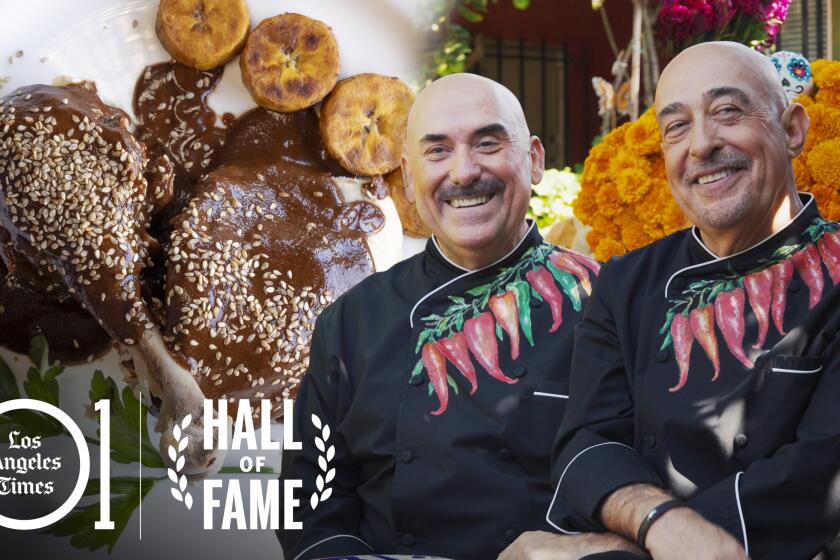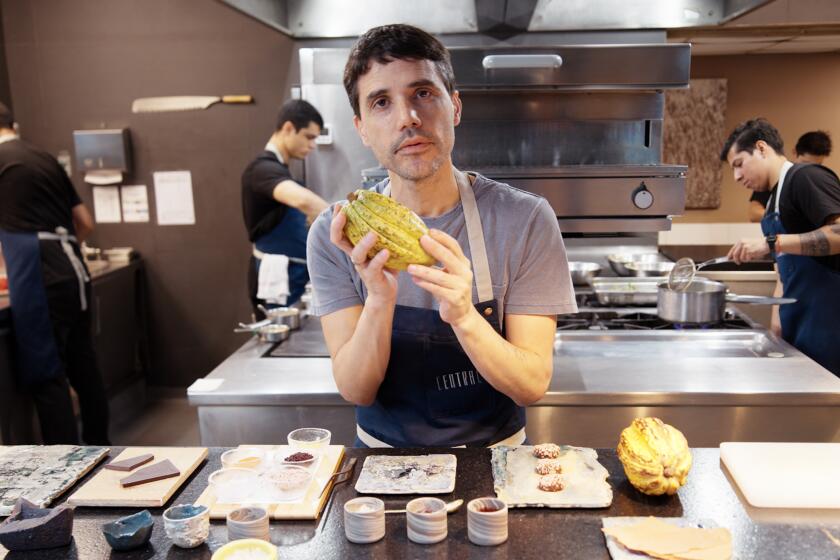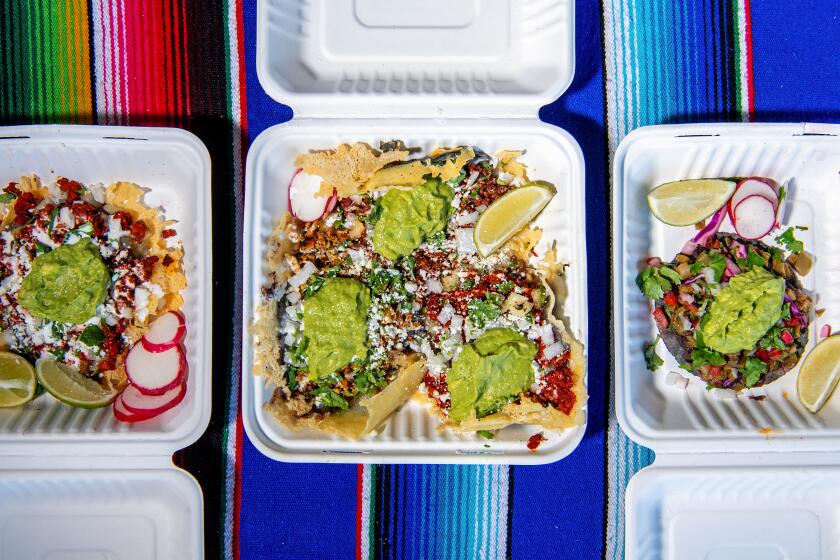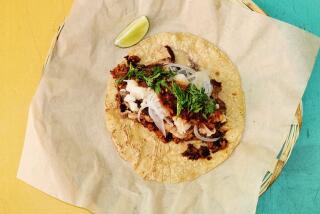
- Share via
To warm up in the crisp of frigid mornings or at the dawn of life, for energy and vitality, there is atole.
Atole is a warm beverage hailing from pre-Hispanic Mesoamerica that’s flavored by fruits, commonly thickened with masa or pinole and sweetened with honey. Today, the types of flavors that exist within atole, both sweet and savory, are long and regional, ranging from North to Central and South America.
Maíz, the result of a culture and millennia of agricultural devotion, was ground and simmered down into what we know as atole, with and without the use of nixtamal. The latter, known as pinole, typically uses blue or purple corn and is as its Nahuatl name, pinolli, suggests: roasted and ground maíz.
🎃 Origins and evolution of ancient ingredients 🍫
This ancient beverage — suggested to be more than 9,000 years old — continues to nourish people in a multitude of facets today. From birthing to healing matriarchal connection, through long treks on foot and more, this nutritious beverage is heralded for its health benefits by Mexican and Indigenous chefs, birth workers and business owners.
For community cook and birth worker Sewa Yuli, who operates as Mi Xantico, atole was a love language shared with their grandmother.
“[It] was a staple nourishment that I could count on having every time I visited my abuelita; it was how she showed her affection,” Yuli said.
This show of cariño has translated to the core of their birth-work practice.
“The matriarchs of my lineage have all taught me the importance of atole during all stages of gestation and post-birth, as well as baby’s first solid food,” Yuli said.
Grandmothers are always eager to give advice, and mine is no exception--especially if there’s a cold to be dealt with.
Atole provides energy during labor and is rich with nutritional value.
“[Atole] is full of B vitamins, antioxidants, magnesium, zinc, fiber and potassium,” Yuli said. According to Yuli, atole as a baby’s first food activates a crucial key to the genetic memory of maíz. “When we make this drink, it is not just an act of love but an act of preservation, resistance and activation. [Atole] is the embrace of our ancestors.”
Chef Denise Vallejo of Los Angeles-based Alchemy Organica noted a similar matriarchal connection during a dinner last year with clinical therapist Vero Cabrera-Rodriguez. The event was titled La Ofrenda, in theme with the then-upcoming Día de Muertos holiday, which moved through ancestral healing paired with a five-course dinner.
“To open the constellation session, I served the guava atole as a way to help ground and comfort our guests,” Vallejo said.
It proved to be a powerful experience for eventgoers, reminding them of their grandmothers.
“It was so well received. Most every guest had some type of taste memory sparked — fond memories of a similar drink being served to them by their abuelitas. The faint tropical smell of guavas triggered so much nostalgia, some folks were brought to tears,” Vallejo said.
Vegan baker Roxanne Sanchez of Delicias Bakery & Some in Highland Park says her grandma would prepare pinole for her each visit.
“Pinole holds a very special place in our hearts. We would eat it almost every day, I have the taste and smell memorized,” Sanchez said.
Roasted vegetables are served in a rich corn broth made from fresh and dried corn and green chiles in this Oaxacan dish.
The atole de pinole that she eats is like a cereal or oatmeal, eaten with a spoon and warm milk. When she gathers with her family around the table to enjoy pinole, they exchange memories of being at her grandma’s.
“Every time I take a big spoonful of pinole I think of her, and that moment alone is healing, even if short,” Sanchez said.
Pinole is also a therapeutic for its dense nutritional value, according to Sanchez. It is an ancestral superfood to Zacatecanos like her parents, she says.
“When I have a bad day and don’t nourish myself [well], pinole is there, instantly healing me with its nutrients,” she said.
A behind-the-scenes look at Jaime Martín Del Campo and Ramiro Arvizu’s La Casita Mexicana, named in 2023 to the L.A.
The Rarámuri or Tarahumara peoples of Chihuahua, Mexico, notoriously power their long-distance running with pinole. One of their long-distance treks can accumulate as many as 400 miles in 50 hours on pinole and chia seeds alone.
Eddie Sandoval, whose parents are from Chihuahua, Mexico, has built a company, Pinole Blue, selling pinole products that range from instant atole mixes to pinole “endurobites.”
Sandoval describes these ingredients from a nutritional lens: “Blue corn has the same antioxidants as blueberries, [and] more protein than yellow or white corn.”
According to registered dietitian Alex Caspero, “Just two ounces of pinole provides 7 grams of fiber, 40 grams of complex carbohydrates, and 100 milligrams of anthocyanins; a specific antioxidant that may help reduce rates of cardiovascular disease and cancer and boost cognitive function,” she wrote for the Food Network.
Alejandro and Alberto Rodriguez, brothers, co-owners and chefs of pop-up Molino Dos Caras in Denver also hail the nutritional benefits of atole by adhering to pre-Hispanic-style recipes.
“As nonvegans creating a vegan atole, I feel it aligns more with pre-Columbian techniques of Mexican cookery that we try to adhere to,” Alberto said.
The Rodriguez brothers grew up eating a lot of “accidentally” vegan meals; it was how their grandmother cooked.
“Our family were never big fans of dairy. ... From a culinary standpoint it allows the masa or pinole [to] shine without the obtrusive flavors of dairy taking over,” Alejandro said.
There’s nothing quite like the all-in experience of Victor Villa’s queso tacos, made in a style that epitomizes the L.A. dreamer, the go-getter.
Moreover, Alejandro emphasizes a cup of atole alone can serve as a complete breakfast.
“With all of the nutrition whole grain corn offers, it can sometimes stand for its own meal,” Alejandro said.
This nutritious beverage, whether flavored with orange marmalade and cempasúchil like Molino Dos Caras, simmered down with pumpkin like chef Vallejo, or with pistachio like Yuli, remains largely unchanged from its original recipe, bearing with it a wisdom that stretches multiple generations and brings cariñito that bolsters the body and soul.
Andrea Aliseda is a food and culture writer, vegan recipe developer and dog mom based in Brooklyn, N.Y., with published work in Harper’s Bazaar, Bon Appétit and Epicurious. She’s currently working on her debut plant-based Mexican cookbook, and you can find her on Instagram at @andrea__aliseda.
More to Read
The Latinx experience chronicled
Get the Latinx Files newsletter for stories that capture the multitudes within our communities.
You may occasionally receive promotional content from the Los Angeles Times.











